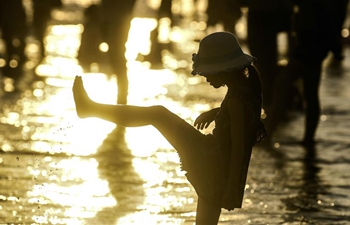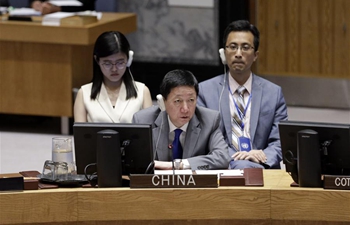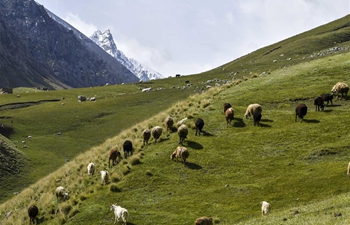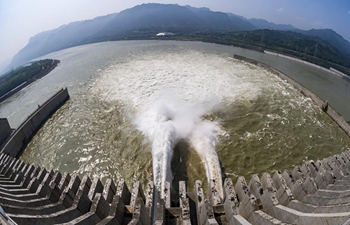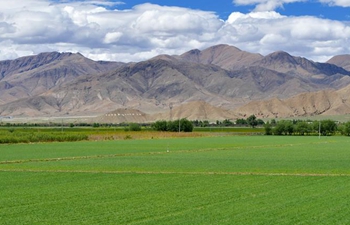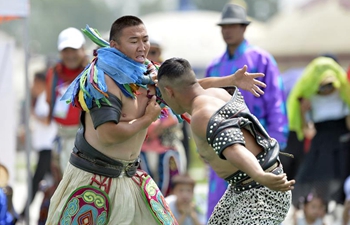by Shristi Kafle
KATHMANDU, June 26 (Xinhua) -- In extremely hot and humid conditions, 37-year-old Subhadra Dhoju was busy working on a soil excavation project in the Ranipokhari area in the heart of the capital of Kathmandu.
With a cap and scarf on her head and plastic boots on feet, the mother of two has been working as a laborer for the last three months to reconstruct quake-damaged Ranipokhari, which refers to the Queen's Pond in English, which dates back to the 17th century.
More than 40 other women from the ancient city of Bhaktapur have joined Dhoju to help restore the square-shaped artificial pond with a temple in its center, the most famous landmark built by the then King Pratap Malla in 1670 AD to console his grief-stricken wife.
"We are very happy to be a part of this restoration project. Since it's a historical pond, to work here itself is a matter of pride. It is very difficult to work in this heat and rain, but who will work if we don't? It's our responsibility to preserve it," Dhoju told Xinhua on Monday.
Dhoju, who learned about construction work from her husband who is a stone mason, never hesitates to grab a spade or a shovel, while many of the women in this South Asian country are still limited to the domestic sphere, doing household chores and raising children.
Ignoring both the soaring temperature and the monsoon rains and challenging the male-dominated profession of construction work, these ethnic Newari women have geared up with verve and gusto to rebuild the historical and cultural heritage site.
The female laborers are being supported by a few male colleagues for the construction of a wall surrounding the pond. However, the majority of the tasks, like digging the land, transporting sand and bricks, clearing grass, preparing the black soil dough for plastering, among all others work, are handled by the women themselves.
"We have experienced working to reconstruct a similar pond called Bhaja Pokhari in our hometown Bhaktapur. We have all been friends since then. It gave us motivation to carry out similar tasks," Dhoju, who is also the group leader, said.
For six days a week, the female laborers work from 10 a.m. to 5 p.m. with an hour long break for lunch. They are paid Rs 1,000 (about 9 U.S. dollars) per day, which is higher than the government-fixed minimum wage for the workers, which stands at Rs 13,450 per month (about 121 U.S. dollars).
The female workers said that they find the wages from the construction attractive in addition to the provision of free transportation to and from the site. For many, it has been a way out to support their families and to end financial dependency upon their husbands.
Thirty-four-year-old Sarina Napit told Xinhua, "My family was dependent solely on my husband's income and it was quite difficult to pay to educate our two sons. With this work, I feel independent and it has given me courage to do something in life on my own."
Sarina does not want to step back if any similar opportunities arise in the future, but rather wants to adopt this profession, as with her male counterparts, to preserve cultural heritage sites for future generations.
Along with Sarina, her friends mentioned in their native Newari language that working in a group of women has boosted their confidence. The reconstruction project has not just helped them to secure independence from the shackles of domesticity but has also directly contributed to nation-building.
The project is under the auspices of the National Reconstruction Authority, which is an authorized body to carry out post-quake rebuilding tasks. For this, the authority has joined hands with the Department of Archaeology, historians, local government representatives of Kathmandu Metropolitan City and has formed a user committee who handles the task at ground level.
The user committee, made up of local residents, finds female laborers more sincere and dedicated to their work and highly appreciates their performance.
Roshan Kaji Tuladhar, secretary at the Ranipokhari Reconstruction User Committee, told Xinhua, "It is a positive aspect that women have started coming to the forefront. They are working for heritage preservation, which is really impressive. Since they had expertise in such areas, we encouraged them to carry out this task."
It took nearly four years to begin the reconstruction of the iconic Ranipokhari, which used to be opened only once a year during Bhai Tika, the most important day of Nepal's second-biggest festival Tihar. On this particular day, people who don't have brothers and sisters used to visit Ranipokhari to receive tika and blessings.
To bring the pond back to its original form, the committee has planned to dig underground channels to utilize rain water to maintain the water volume.
"Instead of using modern methods and materials, we are using only black soil, sand and traditional bricks to maintain the authenticity of the heritage site," Tuladhar said.
According to the National Reconstruction Authority, the pond is being restored at a cost of around Rs 100 million (about 900,000 U.S. dollars). The reconstruction of the Balgopaleshower temple located in the center of the pond and the connecting bridge is yet to start and will be handled by a commercial contractor.
Tuladhar is hopeful that with the efforts and dedication of the female laborers, the Malla Era historic monument will be open to the public in October to coincide with the upcoming Tihar festival. Enditem

